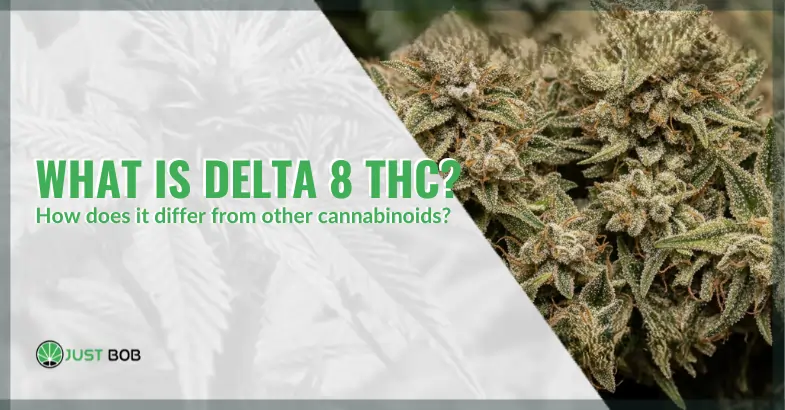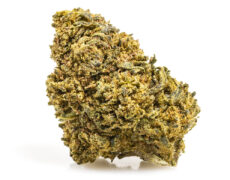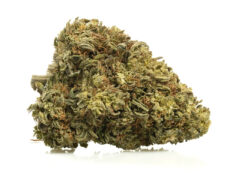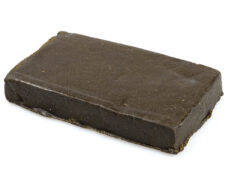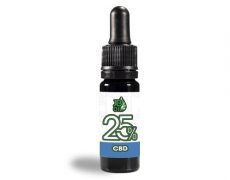Published on: 07/11/2025
This cannabinoid is synthetically produced from CBD and operates in a regulatory gray area, raising growing health concerns
In the complex universe of cannabis, studded with hundreds of chemical compounds, one name has emerged strongly in recent years, capturing the attention of scientists and legislators: Delta-8-tetrahydrocannabinol, or more simply Delta-8 THC.
This cannabinoid, a close relative of the better-known Delta-9 THC, has gradually established itself on the global market, gaining a well-defined role as an alternative considered to have less intense effects (despite many authoritative studies, such as this one, questioning this belief).
Its growing popularity has forced authorities to intervene with specific studies and analyses, faced with a complex legal framework characterized by often inconsistent or divergent regulations between different countries.
However, its rapid growth in popularity is not without criticism and raises important questions, particularly regarding its safety, product standardization, and its actual regulatory status, issues that continue to generate debate in both scientific and institutional circles.
Before delving into the analysis of this molecule, a preliminary remark is essential.
The following discussion is for informational and educational purposes only. The laws regulating cannabis and its derivatives vary dramatically from country to country and even within individual jurisdictions.
It is therefore the responsibility of each individual to inform themselves and strictly comply with the regulations in force in their territory. It is always worth reiterating that this article is in no way intended to encourage behavior that is not in line with the law.
Read also: Cannabis Alkaloids Uncovered: The Hidden Chemistry of the Hemp Plant
The Chemical Identity Card: What Exactly is Delta-8 THC?
To understand Delta-8, we need to start with chemistry. Its full name, delta-8-tetrahydrocannabinol, already identifies it as a relative of delta-9-tetrahydrocannabinol, the molecule responsible for the main psychotropic effects of cannabis.
To be precise, the two compounds are structural isomers: they share the same molecular formula (C₂₁H₃₀O₂), which means that they are composed of the same number and type of atoms, but differ in their spatial arrangement, as clearly shown in the research paper “Chemistry and Pharmacology of Delta-8-Tetrahydrocannabinol.”
The difference, which appears infinitesimal, lies in the position of a carbon-carbon double bond within their molecular architecture. In Delta-9 THC, this bond is located on the ninth carbon atom of the chain; in its “cousin,” as the name suggests, it is located on the eighth.
This detail may seem insignificant to the uninitiated, but it proves to be decisive for the biological behavior of the molecule and the way it interacts with our body. This different spatial configuration gives Delta-8 greater chemical stability: it is more resistant to oxidation, a process that converts Delta-9 into cannabinol (CBN), and consequently has a potentially longer shelf life.
The history of its discovery is not recent. Delta-8 THC was first synthesized in 1941 by American chemist Roger Adams at the University of Illinois.
However, it was not until 1966 that its chemical structure was fully characterized thanks to the work of Raphael Mechoulam, the Israeli pioneer of cannabinoid studies.
Despite its presence in nature in the cannabis plant, its concentrations are extremely low, usually less than 1%. For this reason, almost all of the Delta-8 in circulation today is not extracted directly but obtained through a chemical synthesis process.
It is precisely for this reason that the authorities are carefully analyzing the phenomenon: because the dangers to public health should not be underestimated, far from it!


From Plant to Laboratory: The Production Process
The spread of Delta-8 is closely linked to another cannabinoid: cannabidiol (CBD).
Thanks to regulations such as the 2018 Farm Bill in the United States, which legalized the cultivation of industrial hemp (defined as cannabis with a Delta-9 THC content of less than 0.3%) at the federal level, CBD has become widely available.
Producers quickly realized that it was possible to convert non-psychoactive and legal CBD (like CBD oil, for example) into Delta-8 THC through a chemical process called isomerization.
This process, which is usually acid-catalyzed, uses solvents such as toluene or hexane and strong acids to reorganize the molecular structure of CBD until it is transformed into that of Delta-8.
The biggest safety concerns arise in countries that allow CBD and legal hash.
If the process is not carried out in specialized laboratories with rigorous purification procedures, the final product may contain not only residues of the solvents and acids used, but also a series of unwanted by-products, including other isomers such as Delta-10-THC or compounds that have not yet been fully studied.
This lack of standardization and quality control in states where cannabidiol is not prohibited exposes people to significant risks.
Interaction with the Body: Mechanism of Action and Perceived Effects
Once introduced into the body, how does Delta-8 work?
Like all cannabinoids, it interacts with the endocannabinoid system, a complex network of receptors and neurotransmitters that regulates numerous physiological functions, including mood, appetite, sleep, and pain perception.
The main targets of THC are type 1 (CB1) cannabinoid receptors, concentrated mainly in the central nervous system, and type 2 (CB2) receptors, found primarily in the immune system.
The structural difference between Delta-8 and Delta-9 results in a different binding affinity with these receptors. In particular, Delta-8 THC binds to CB1 receptors with less force than Delta-9. This lower affinity is the scientific reason why, according to some studies, its psychoactive effects may generally be perceived as milder.
However, other analyses refute this assumption, observing that the difference is not as marked as previously thought. At sufficient dosages or when inhaled, it can produce almost identical effects, while maintaining a different metabolic profile.
This molecule is thought to produce a feeling of euphoria and relaxation, but with less likelihood of triggering the anxiety, paranoia, or mental fogginess that some individuals associate with Delta-9 THC consumption.
Reported effects also include anti-nausea properties, appetite stimulation, and analgesic action.
Some preliminary research suggests a therapeutic potential for the treatment of conditions such as chronic pain or nausea, but it is important to note that the scientific literature is still largely incomplete. There is a lack of large-scale clinical studies in humans that can definitively confirm its efficacy and, above all, its long-term safety.
Its metabolism follows a similar path to that of Delta-9: once in the liver, it is transformed by specific enzymes (of the cytochrome P450 group) into an active metabolite, 11-hydroxy-Δ8-THC, and then converted into an inactive compound and eliminated through urine.
A Direct Comparison: Differences with Other Cannabinoids
To properly understand Delta-8, it is useful to compare it with its closest relatives.
- Delta-8 THC vs. Delta-9 THC: this is the most immediate comparison. Both are psychoactive and produce similar effects, but the real distinction lies in their intensity. Delta-9 is primarily responsible for the “high” associated with cannabis, with perceptual alterations, marked euphoria, and, in some individuals, side effects such as anxiety and tachycardia. Delta-8 offers a similar experience (according to some, more subdued, more controllable, and with fewer side effects, but this has not been confirmed).
- Delta-8 THC vs. CBD (Cannabidiol): here the difference is enormous. CBD is not a psychoactive compound, which means that it does not produce any alteration in the state of consciousness. It does not bind directly to CB1 receptors, but acts on the endocannabinoid system through more complex mechanisms. In countries where it is permitted for therapeutic use, it is valued for its potential anti-inflammatory, anxiolytic, and anticonvulsant properties, and its use is mainly oriented towards wellness and medical contexts, without any recreational purpose related to intoxication.
- Delta-8 THC vs. Delta-10 THC and Other Minor Cannabinoids: Delta-10 THC is another isomer of THC, with the double bond in the tenth position. Its effects appear to be even milder and tend to be more energizing than sedative, but research on this is even scarcer. Other cannabinoids such as CBG (cannabigerol) or CBN (cannabinol) have completely different profiles: the former is studied for its neuroprotective properties, while the latter is often associated with sedative effects. Compared to these, Delta-8 remains firmly in the realm of psychoactive compounds.
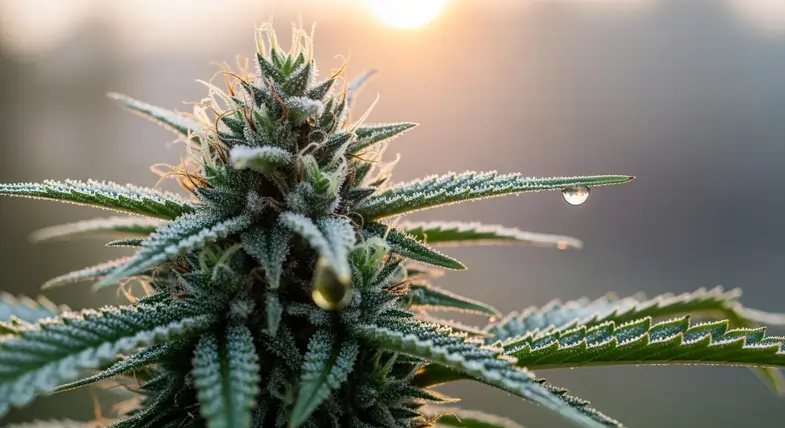

A recently popular substance, between legal uncertainty and health risks
The rapid rise of Delta-8 is not a coincidence, but rather the result of its peculiar legal status. Derived from hemp, it has escaped the strict restrictions applied to cannabis with high Delta-9 THC content in many places.
This spread has occurred in a regulatory vacuum. Health authorities, such as the US FDA, have expressed strong concern. The lack of regulation means there is no control over the quality, purity, and labeling of products.
A study published in Frontiers in Psychiatry (2023) describes three clinical cases of patients hospitalized for psychotic symptoms that arose during regular use of Δ8-THC.
The report highlights a possible correlation between this cannabinoid and the development of psychosis, emphasizing the need for further research and greater clinical attention, as Δ8-THC, although considered milder than Δ9-THC, can induce similar adverse effects, including hallucinations and paranoia.
More worrying are recent data.
A 2024 study found that 11% of American high school seniors had used Delta-8 in the previous year, highlighting its significant penetration even among younger people. The main risk lies not so much in the molecule itself, but in what accompanies it: contaminants, unknown by-products, and concentrations declared on the label that often do not correspond to reality.
Read also: Cannabinoids: short and long term effects
Conclusion: a still unknown molecule that raises concerns
Delta-8 THC acts as a chemical and pharmacological link between the intensity of Delta-9 THC and the non-psychoactive nature of CBD.
However, its story also serves as a warning sign: the absence of a clear regulatory framework has fostered the emergence of a poorly regulated market, in which supply has developed much more rapidly than scientific evidence and public health safeguards.
The future of this substance will depend on the ability of research to provide solid data on safety and long-term effects, and on the decisions of legislators, who are called upon to balance innovation, consumer protection, and regulatory clarity. Until then, Delta-8 remains an open and controversial topic in the cannabis debate.
In conclusion, we reiterate that this article is for informational purposes only. The aim is to provide a clear overview based on current scientific knowledge about Delta-8 THC, with no intention of promoting or encouraging illegal behavior.
It is the duty of every citizen to inform themselves and always act in full compliance with the regulations in force in their country or region of residence, as the law always takes precedence.
See you in the next Just Bob article on the world of CBD cannabis, see you soon!
Delta-8 THC: takeaways
- Delta-8 THC is an isomer of the better-known Delta-9 THC (the main psychoactive compound in cannabis). It shares the same chemical formula but has a slightly different structure, which results in slightly milder psychoactive effects.
- Much of its popularity stems from the fact that it is chemically produced from CBD extracted from hemp. This origin places it in a regulatory limbo in many jurisdictions, also generating great legal and regulatory uncertainty.
- The unregulated production of Delta-8 THC raises significant safety concerns. Synthesis processes can leave harmful chemical residues and generate unknown by-products in the final products, which are rarely subjected to rigorous quality controls, posing a serious health risk.
Delta-8 THC: FAQ
What is Delta-8 THC in simple terms?
Delta-8 THC is a compound found in the cannabis plant, very similar to traditional THC (Delta-9), but with significantly milder psychoactive effects. Many users describe it as an experience that offers relaxation and mild euphoria without the intensity or anxiety that Delta-9 can sometimes cause.
Is Delta-8 THC the same as the THC commonly found in marijuana?
Although they are chemically very similar (they are isomers), the THC commonly found in marijuana is Delta-9 THC, which is significantly more potent. The slight difference in their molecular structure causes Delta-8 to bind less effectively to receptors in the brain, resulting in a milder psychoactive effect.
Are Delta-8 THC products safe to consume?
Safety is a major concern. Since the market is largely unregulated, product quality can vary greatly. The manufacturing process can leave harmful chemical residues and untested byproducts. Without independent lab testing and clear regulation, it is impossible to guarantee the purity and safety of a Delta-8 product.

